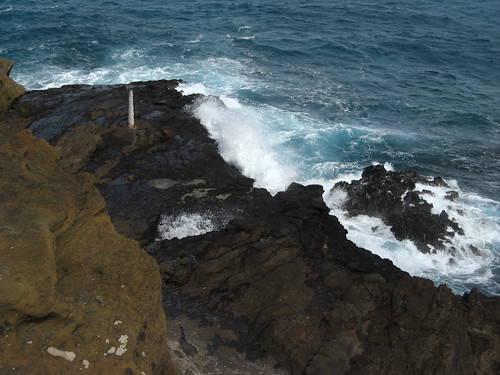自然界的控溫術 太平洋強風答暖化停滯說
Category: 水新聞 Created: Friday, 26 December 2014 02:20研究顯示,太平洋信風的變化跟20世紀的氣候變化息息相關,因此可能影響未來的全球氣溫。
暖化緩步揭謎底 熱帶強風是關鍵
美國國家大氣研究中心(NCAR)和亞歷桑納大學的科學家使用一種新的測量方法,分析珊瑚的化學變化後發現,熱帶太平洋信風的轉弱,和20世紀早期的全球暖化溫度有所關聯。
「熱帶太平洋強風過去15年間扮演減緩暖化的重要角色。當風減弱,暖化就會開始加速。」研究主要作者、NCAR博士後科學家Diane Thompson說。
即使全球持續排放二氧化碳和其他溫室氣體,研究結果仍顯示,「太平洋信風變強讓全球暖化趨緩」的理論獲得支持。
Thompson團隊的研究指出這樣的過程過去就曾發生,也可能以相反的方式發生──風減弱、暖化加速。作者指出,當太平洋信風因自然週期改變,暖化就會再度開始。
「我們正試著瞭解自然變化的規律,讓科學家更能預測未來氣候變遷的走向。」共同作者、亞歷桑納大學教授Julia Cole說。
研究本周發表於《自然地球科學》期刊,由國家科學基金會、國家海洋大氣管理局、亞歷桑納大學、慈善教育機構、英國自然環境研究委員會和美國能源部資助。
消失的熱能 自然界自動控溫
2001年起,即使溫室氣體增加,全球表面溫度並沒有明顯上升。這個全球暖化停滯的現象引起許多氣候科學家注意,試圖尋找消失的熱能。
科學家用氣候模型和觀察發現,熱可能因為大氣循環的關係進入了海洋。這讓大氣中的熱能減少,暫時抵消了溫室氣體造成的暖化效應。
今年稍早,一組國際氣候科學家團隊發表研究於於《自然氣候變化》期刊指出,赤道附近異常強烈的太平洋信風把熱導入海洋,同時把較冷的海水帶往表面。
風只是造成氣候改變的一個因素。氣溫在20世紀中葉趨穩也和工業化增加、排放到空氣中的粒子阻擋了陽光導致溫度降低有關。20世紀末期,溫室氣體排放增加扮演主要角色。
「研究顯示,風影響氣候並不是新聞,這個機制早就在作用。我們相信這對瞭解自然規律調控溫度變遷有重要的貢獻。」Thompson說。
Shifts in Pacific trade winds played a key role in 20th century climate variation, a sign that they may again be influencing global temperatures, new research indicates.
The study, led by scientists at the National Center for Atmospheric Research and the University of Arizona, uses a novel method of analyzing chemical changes in coral to show that weak tropical Pacific trade winds coincided with globally warming temperatures early in the 20th century.
When the natural pattern shifted and winds began to strengthen after 1940, the warming slowed.
The finding gives support to the theory that strong Pacific trade winds are currently helping to prevent global temperatures from climbing, even as society continues to emit carbon dioxide and other greenhouse gases.
When the winds weaken as part of a natural cycle, warming will likely resume once again, the authors say.
“Strong winds in the tropical Pacific are playing a role in the slowdown of warming over the past 15 years,” said lead author Diane Thompson, a postdoctoral scientist at NCAR. “When the winds inevitably change to a weaker state, warming will start to accelerate again.”
“We’re trying to understand how those natural variations work so that scientists can do a better job of predicting the actual course of climate change into the future, ” said University of Arizona professor Julia Cole, a co-author.
The study is being published this week in the journal “Nature Geoscience.” It was funded by the National Science Foundation, NCAR’s sponsor, as well as by the National Oceanic and Atmospheric Administration, University of Arizona, Philanthropic Education Organization, U.K. Natural Environment Research Council, and the U.S. Department of Energy.
Despite increases in greenhouse gases, global surface temperatures have not risen significantly since 2001. This pause in global warming, often called the hiatus, has become the focus of research by climate scientists who are trying to track the missing heat.
By using climate models and observations, scientists are finding evidence that the heat is going into the subsurface ocean, perhaps as a result of changes in atmospheric circulation.
A study earlier this year in the journal “Nature Climate Change” by an international team of climate scientists, pointed to unusually strong trade winds along the equator in the Pacific Ocean that are driving heat into the ocean while bringing cooler water to the surface.
This is leaving less heat in the air, temporarily offsetting warming from increasing greenhouse gases.
The study by Thompson and her colleagues indicates that this process has happened before, and in the opposite direction – weaker winds allowed warming to accelerate.
Winds are just one contributor to changes in global climate. Another reason that temperatures leveled off in mid-century likely has to do with increased industrialization and emissions of particles that block sunlight and exert a cooling influence. Later in the century, increased emissions of greenhouse gases played a dominant role.
“This research shows that the influence of winds on climate is not anything new. These mechanisms have been at work earlier,” Thompson said. “We believe this is a significant contribution to understanding the role of natural processes in modulating global temperature change.”
※ 全文及圖片詳見:ENS
Read more http://e-info.org.tw/node/104216









